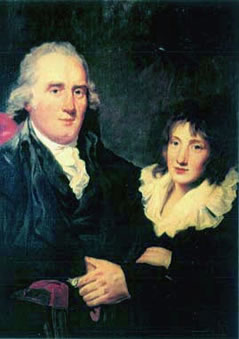
Portraits from the Royal Infirmary of Edinburgh Boardroom
John Hill (c. 1747-1805) & Son
Connection with the Royal Infirmary: Portrait presented to the Infirmary by Captain Norman Hill
Artist: Style of Raeburn
Date of Portrait: c. 1801
John Hill was Professor of Humanity (Latin) in Edinburgh University from 1775-1805. Educated at St. Andrews, he first became a professor there before transferring to Edinburgh. As well as performing the teaching duties of the Chair, he wrote a Life of Dr Hugh Blair and a book of Latin Synonymes. In his History of the University of Edinburgh, Sir Alexander Grant summarises Hill's life somewhat ambiguously, saying: "He was said to have had a great flow of spirits, and to have been an excellent punster." Perhaps there is some indication of both these qualities in the portrait. In this case, however, the story behind the portrait is of equal, if not more, interest than either the sitter or the artist.
In April 1902, the Infirmary was first offered the portrait under the terms of the will of Captain Norman Hill, the professor's grandson. The Managers were informed that a Mr Philpot of Old Bond Street, London, had identified it as by Henry Raeburn (1756-1823), the most distinguished Scottish portrait painter of his generation, and he valued it at £600. The agents for Hill's Trust, Messrs Pontifex, Hewit and Pitt, informed the Managers that the Captain's widow was prepared to give the portrait to them immediately, even though the will expressly stated that they should only receive it after her death. The condition was that the Infirmary paid the "excess legal duty", plus Philpot's valuation fee. Taken together, it amounted to £90, still a considerable sum at the turn of the twentieth century. The Managers agreed to this and even sent a special messenger to London to bring the portrait safely to Edinburgh.
When the portrait finally arrived, they sought conservation advice about flaking off paint in certain areas of the canvas. In his report, James L. Caw, the Curator of the Scottish Portrait Gallery, felt honour-bound to point out that this was not the Scottish masterpiece that had been eagerly expected, but an inferior copy. Caw's artistic sensibilities were clearly outraged by the misattribution and he went so far as to say that, although it might be in the style of Raeburn and even painted in his studio, it was clear that the master's brush had never been stroked across it. The representation of the son in particular was crudely done (note the boy's left hand) and may have been added by another artist at another time. Instead of being worth its Old Bond Street valuation, it would fetch less than £20.
Subsequently, other opinions confirmed this and it emerged that an original near full-length Raeburn was still in the possession of a Mr Charles Cook of Redgrave Crescent, Edinburgh. Upon further investigation, the Managers found that the high valuation of the portrait had been used by Pontifex, Hewit and Pitt to pay the probate duty on the will, when it should have formed a charge on the estate. So it does seem likely that, for once, the Managers were misled and even duped. In characteristically tenacious fashion, they tried to get the excess duty they had already paid back from the Inland Revenue, with what success, however, is unfortunately not recorded.
The whole episode shows how it was essential for the hospital to scrutinise the terms of each bequest it received and that the Law Committee, whose job this was, formed an essential part of the Infirmary's organisation during its period as a voluntary hospital. The real Raeburn was subsequently given to the University and can still be seen in their portrait collection.
Designed by the Learning Technology Section, © The University of Edinburgh

